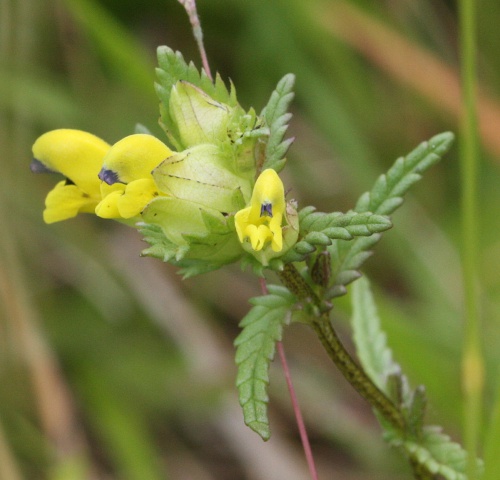
This verge is being managed to benefit wildlife. Here are some of the wildflowers and other species found here. To see a full list and get up to date with the verge project, visit NatureSpot's Wild Place feature page for this verge. Click on any header to visit the NatureSpot page for that species to find out more.
Yellow-rattle
This attractive plant is a parasite! Its roots attach to those of nearby grasses to feed off their nutrients, reducing their vigour thereby making more room for other flowers. Because of this it is often seeded into new meadows. By July, the seeds are held in paper-thin capsules where they rattle in the breeze. It is annual and requires exposure to winter frosts for the seeds to germinate.
How to ID: It grows to 40cm, has yellow flowers protruding from a capsule. Leaves are serrated in opposite pairs.
Where to see it: Meadows, verges.
Similar species: None.
Cuckooflower
Also called Lady's Smock. It is the main caterpillar food plant for the Orange-tip Butterfly.
How to ID: Short, clusters of pale lilac flowers on a single stem.
Where to see it: Damp grassland, April-June.
Similar species: None.
Meadow Buttercup
The 'classic' meadow buttercup, growing to around 60cm.
How to ID: Typical yellow buttercup flower. Leaves are deeply divided and resemble large green snowflakes!
Where to see it: Established meadows.
Similar species: Creeping Buttercup (3 leaflets in a triangle) and Bulbous Buttercup (downward pointing sepals under the petals).
Creeping Cinquefoil
The name tells you a lot about this plant (if you speak French!). Cinquefoil means 5 leaved and it is certainly a creeper, sending out long runners. It is a very short plant so does best near paths and at the edges of verges.
How to ID: Yellow flowers and 5 leaflets spread in a circle.
Where to see it: Path edges, bare or disturbed ground.
Similar species: None.
Lesser Celandine
One of the first flowers to appear in early Spring, bringing a welcome nectar source to bees and butterflies emerging from hibernation.
How to ID: Glossy, dark green, heart-shaped leaves. Bright yellow flowers.
Where to see it: Woodland, hedges, verges - prefers shady areas.
Similar species: None.
Yorkshire-fog
A very soft grass - covered in fine hairs (its scientific name 'lanatus' means woolly). Supposedly named because from a distance the flowering grass looks like low-lying smoke, such as that from Yorkshire factories.
How to ID: Stems soft and hairy. The flowers have a pink tinge when fresh, getting more straw-coloured with age. Base of the stems have red stripes.
Where to see it: Most grassland habitats.
Similar species: Creeping Soft-grass has similar flowers but hairless stems (apart from the hairy joints).
Cock's-foot
Perhaps the most recognisable of all our grasses with the clumpy flowers on short but spread stalks. It likes nutrient-rich soil so can become dominant in certain conditions.
How to ID: A tall grass (to 1m) with tussocky leaves that are greyish green. Stalks are flattened. The flower-head is unique.
Where to see it: Meadows and verges.
Similar species: None.
7 Spot Ladybird
One of our larger ladybirds (up to 8mm), sometimes seen in huge numbers.
How to ID: Red with 7 black spots.
Where to see it: Everywhere! Feeds on aphids.
Similar species: Adonis Ladybird is also red with 7 black spots but is smaller and thinner.
7 Spot Ladybird
One of our larger ladybirds (up to 8mm), sometimes seen in huge numbers.
How to ID: Red with 7 black spots.
Where to see it: Everywhere! Feeds on aphids.
Similar species: Adonis Ladybird is also red with 7 black spots but is smaller and thinner.
Dock Bug
Breeding on docks, this large insect can be a common find on its leaves. In late summer the larvae are common, often in family groups with the adults.
How to ID: 13-15mm. Brown with a broad oval abdomen. The two small projections between the antennae are diagnostic.
Where to see it: On docks.
Similar species: The Box Bug is a similar colour but much slimmer in shape.









